Tomb of Tutankhamen, mysterious story
There is one place in the Valley of the Kings in Egypt among the sandy mountains. Located close to ancient city Thebes (modern Luxor). The dry valley has no vegetation. It is impossible for a traveler to find protection and shade from the tireless sun in these parts. The terrain is a mixture of sand and small stones. The air temperature in this part of the country during the winter months is steadfastly kept at around + 40-45C. In the summer season it reaches +60C.
It was this place with an unremarkable desert landscape about 3,000 years ago that the pharaohs of Ancient Egypt chose to find another life in the other world. Surrounded after death by countless treasures, they hoped that the robbers of the tombs would not be able to find them. Their efforts were unsuccessful: almost all the crypts of the royal people of the pharaonic dynasty were looted. With the exception of one – the tomb of King Tutankhamen, who died at the age of 18 in 1346 BC.
Egyptian priests and Tutankhamun’s tomb
There is historical evidence that intruders repeatedly tried to find the resting place of the Egyptian pharaoh. However, the priests who guarded the tomb in reburied Tutankhamun. The whereabouts of his remains remained a mystery for more than 3,000 years. Encased in a massive sarcophagus of pure gold, the Egyptian king was in complete darkness and incomprehensible silence. All this time he was in the world of luxury of the palaces of the pharaohs familiar to him. Golden chariots, statues of precious metal and ebony, wooden boats for traveling to the other world. His golden throne, toys of the king, fragrant oils, precious jewelry and other items that accompany a royal person during her lifetime. Every corner, every niche of this tomb of the pharaoh of Egypt was filled with priceless objects for culture and history. ancient civilization on the ground

Significance of the discovery of Tutankhamun’s tomb
The English Egyptologist, Howard Carter, suggested that Tutankhamun’s tomb was in the Valley of the Dead in. However, archaeologists stated that all areas of this necropolis have already been studied and among them the crypt of the Egyptian king was not found.
In 1914, with the financial and organizational support of the British-born Lord Carnarvon, Carter began his own excavations. For seven years, his labors did not bring any result. Sponsors threatened to stop allocating money for the search. As a result, in November 1922, Lord Carnarvon announced that he could no longer support the project to find the tomb and believed that luck had changed Carter. At the same time, the Egyptian workers were just one step away from one of the most important finds in the history of mankind: they discovered a path leading to the sealed door of the tomb of the son of the Sun.

Treasures of Tutankhamun’s tomb. 1924
Tomb of Tutankhamen: the history of the discovery
Opening this door, the Carter expedition discovered a corridor filled with stones and rubble. After the passage, another obstacle arose before the archaeologists, but this time the entrance was marked with the symbols of King Tutankhamun. Carter was sure he had found the king’s tomb. But he was afraid that perhaps it had been plundered and not a single pharaoh’s regalia remained inside.

On November 26, Carter and Lord Carnarvon began breaking down the second door. Carter later declared to the world that it was:
“A day of days, the most wonderful of those that I have ever experienced. It seemed to me that time stood still. We watched workers clear the passage and remove the bottom of the doorway. The decisive moment has arrived. With trembling hands, I stepped into the darkness. The day before, we tested the space outside the door with an iron detector.
He showed that there was complete emptiness behind the wall. It was impossible to consider anything, since we did not use candles during the work due to possible harmful gases underground. Nevertheless, I took out a candle, lit it and advanced inside the newly discovered room. Lord Carnarvon, Lady Evelyn, Carnarvon’s daughter, and Callender’s lieutenant stood by my side, anxiously awaiting “judgment.”
At first I didn’t see anything. The hot air escaping from the chamber extinguished the flicker of the candle. My eyes began to adjust to the light. In the fog, the details of things in the crypt began to clear up. There were animals unknown to me in appearance, statues, objects – everything shone with gold. I was dumbfounded. Lord Carnarvon could not bear the wait and asked me: “Do you see anything?” All I could do was say, “Yes, wonderful things. Widen the passage a little more so we can both see what’s inside.” The room was lit up with an electric flashlight.
Ancient Egypt. Tomb of Tutankhamun
Howard Carter: Opening Tutankhamen’s Tomb
The “Wonderful Things” that Carter saw in this room turned out to be the largest collection of artifacts from the pharaonic era of ancient Egypt ever discovered. But that was just the tip of the iceberg. In a smaller room next to it, there were magnificent treasures. The archaeological expedition took about 2.5 months to thoroughly clean the entrances and make an inventory of the heritage of the ruler of Egypt.
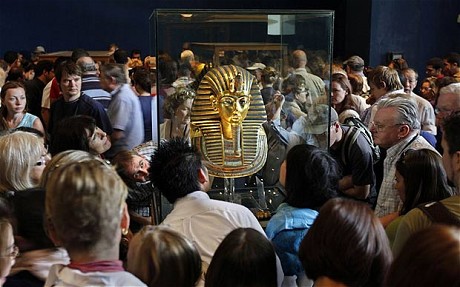
A little later, Carter opened the fourth sealed door, where he believed and located the tomb of Pharaoh Tutankhamun. This is where his richly decorated golden sarcophagus was found.
“My first task was to locate the wooden lintels above the door. I carefully removed the chips from the plaster and removed some of the stones that covered the top layer of the lettering. The temptation to find out what was behind the door was unimaginable. After 10 minutes of work, I made a large enough hole in the wall and inserted a lantern into it. An amazing sight presented itself to me. For there, only half a meter from the door blocking the entrance to the chamber, stood, apparently, a solid wall of gold. I started clearing the gap.”
“Opening of Tutankhamen’s tomb”: documentary was filmed by the BBC channel about the events of this great day in Egyptology.
As the stones were removed from the passage, a real picture emerged: we were at the entrance to the chamber where the king was buried. The wall blocking our way was covered with pure gold and served as a protection for the sarcophagus. Stone by stone, we felt a tremble like an electric shock. It was without a doubt a grave. And we were in it!
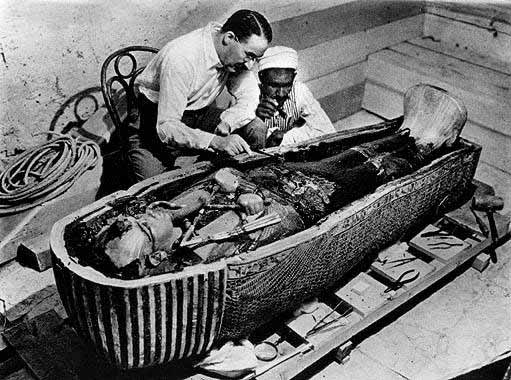
The sarcophagus was huge, 17 pounds by 11 feet. And 9 feet tall. It occupied almost the entire area of the chamber. Space in two steps separated it from the walls on four sides. It almost reached the ceiling in height. From top to bottom it was overlaid with gold. Its edges were lined with inlaid panels of brilliant blue faience. They repeated again and again magical symbols that served to ensure its strength and safety. A number of funerary emblems were laid out around the royal remains. In the northern part, seven oars of a boat were depicted, which served to ferry the pharaoh through the waters leading to the underworld. The walls of the chamber, in contrast to the corridor, were decorated with scenes and inscriptions surrounded by brilliant flowers.
Opening of Tutankhamun’s tomb: video
Ancient Egypt, located in the valley of the longest river in the world, the Nile, belonged to the so-called large river civilizations.
Construction and builders played here very important role, because the state of complex irrigation systems depended on their skill, forcing the river to work for a person, in certain part years, covering the fields with a layer of fertile silt. Soon the ancient Egyptians achieved significant success in the art of building. Starting with irrigation systems, they subsequently moved on to architectural structures proper.
First public entities appeared in the Nile Valley in the 5th millennium BC. e. Subsequently, they united into two great powers – Upper and Lower Egypt. Such names of the state received because of their location along the river. After the unification of Upper and Lower Egypt, the so-called dynastic time begins, it is divided into three periods, which are called the Old Kingdom (III millennium BC), the Middle Kingdom (end of III – beginning of II millennium BC) and the New Kingdom ( middle and second half of the II millennium BC).
Sometimes the events of Egyptian history are dated according to the number of the royal dynasty that ruled at the time when the event occurred.
It so happened that the most famous monuments ancient Egyptian architecture was tombs, especially the Great Pyramids, which the ancient Greeks considered the first of the seven wonders of the world. But throughout their centuries-old history, the Egyptians built the pyramids for a relatively short time. The burial places of the first Egyptian kings and pharaohs have a rather modest appearance. The chamber where the mummy was placed in the sarcophagus was dug out in the soil. An embankment was made on top, which was lined with stone slabs. The resulting building had a flat top and sloping walls. Archaeologists call such a burial place the Arabic word mastaba. Later, when the tombs of the pharaohs became more impressive, noble Egyptians continued to be buried in mastabas.
The first real pyramid was built at the beginning of the III millennium BC. e. architect Imhotep, minister of the founder of the Third Dynasty, Pharaoh Djoser. This pyramid did not have smooth walls, but was stepped. It consisted of five mastabas of different sizes, stacked on top of each other. The Pyramid of Djoser had a height of 30 m, and, apparently, it would be considered very majestic building, if her glory had not been overshadowed by the following.
Pyramids with smooth walls appeared in Egypt during the reign of the pharaohs of the fourth dynasty. At first they were relatively small. But subsequently, three Great Pyramids were built, which belonged to the pharaohs Cheops, Khafre and Mykerin. The height of the largest of them – the pyramids of Cheops – reaches almost 147 m.
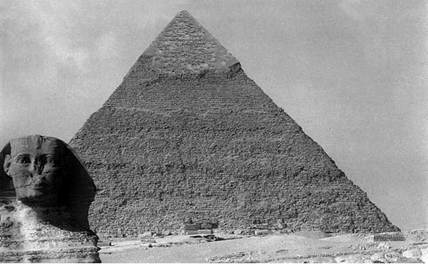
Rock tombs of ancient Egypt
During the Middle Kingdom, the rulers of Egypt abandoned the construction of the pyramids. Currently, rock tombs were built for pharaohs and nomarchs (rulers of regions).
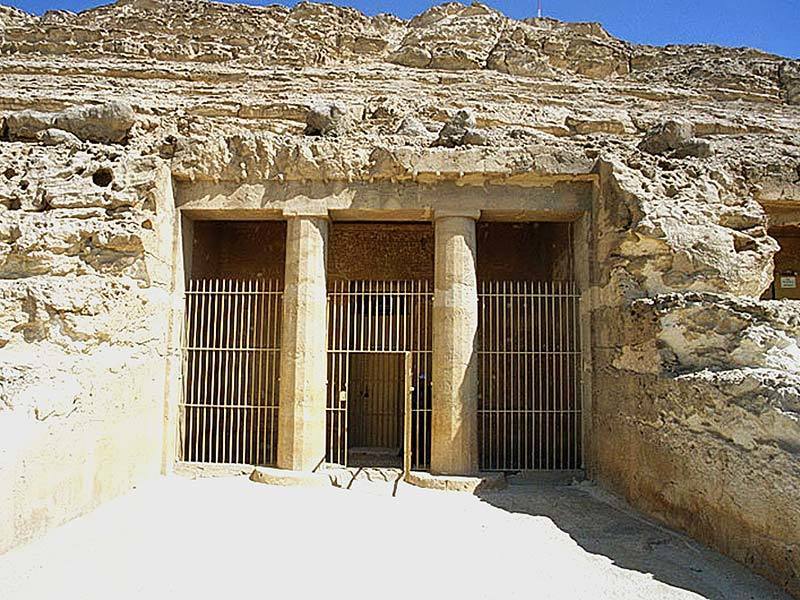
The burial chambers were hollowed out in the thickness of the rock. From the outside, only the entrance was visible, adorned with two squat columns that are called protodoric. Sometimes the entrance was decorated with monumental bas-reliefs. Going inside, you find yourself in a long narrow hall, divided into three parts by protodoric columns. Such a room, divided by supports into parallel galleries, which is called the hypostyle hall in architecture. The walls of the hall were covered with multi-colored frescoes of various contents. Here you can see not only the majestic images of the deceased surrounded by gods, but also surprisingly alive, despite a certain conventionality, genre scenes. Next were the burial chambers, the entrance to which was tightly closed with large hewn blocks.
An outstanding monument of this type is the necropolis in the village of Beni Khasan.
During the New Kingdom, rock burials had no external decorations. The entrance to the tomb was disguised, and in order to get into the chamber with the body of the pharaoh, one had to wander through narrow stone corridors for a long time. Such secret burials were made because they were afraid of robbers, because together with the king they buried countless treasures that were supposed to decorate his existence in the other world. Such secret burials included the tomb of Pharaoh Tutankhamen, known for that archaeologists found it earlier than the ancient robbers.
November 2012 marks 90 years since the English archaeologist and Egyptologist Howard Carter discovered the entrance to the tomb of Pharaoh Tutankhamun in the Valley of the Kings near Luxor. Great treasures awaited the explorers there. And the deaths that followed the discovery gave rise to a wave of rumors about the “curse of the pharaoh.”


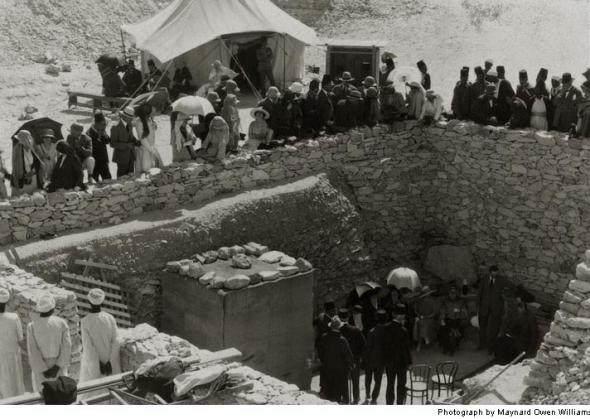
Pharaoh Tutankhamen was a very insignificant ruler and did not become famous in history for absolutely nothing. We only know that he died very young. And if it were not for the monuments from his tomb, the name of Tutankhamen would have been mentioned only in a narrow circle of Egyptologists. But in November 1922, one of the largest archaeological discoveries of the 20th century took place – in the “Valley of the Kings” for the first time, an unplundered royal tomb was discovered, containing a complete burial complex of objects unique in terms of preservation and artistic value.

The honor of opening the tomb of Tutankhamun belongs to the English archaeologist Howard Carter and Lord Carnarvon, who financed the expedition. Wealthy, independent man, sportsman, art collector and traveler who made circumnavigation on a sailboat, Lord Carnarvon, as a young man, became interested in antiquities. 
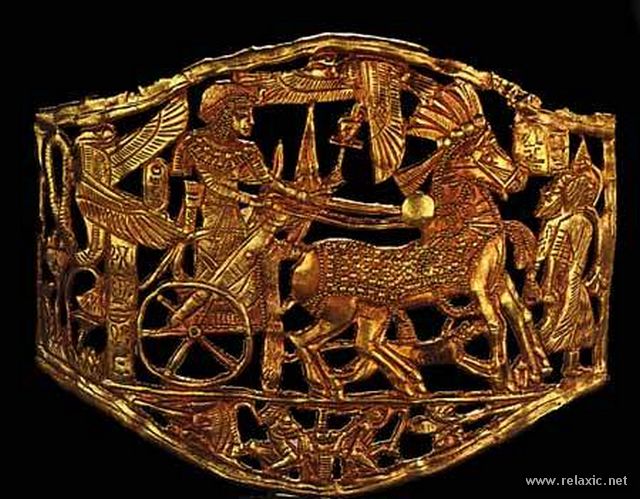
He was a frequenter of antique shops, collecting old engravings and drawings. In archeology, he saw opportunities to combine two passions that overwhelmed him – to sports and gathering, and since 1906, Carnarvon, first on his own, and then in collaboration with professional archaeologist Howard Carter, led excavations in the “Valley of the Kings”. So, as a result of purposeful long-term archaeological searches, a great discovery took place. 


At the beginning of the 20th century, the expedition of the American Theodore Davis discovered in the “Valley of the Kings”, in a cache under a rock, a faience goblet with the name of Tutankhamun on it. Nearby, in a deepening of the rock, sealed clay vessels were found, in which there were headbands of mourners and other items, also with the name of Tutankhamun, and a wooden box was found in the mine-tomb discovered by Davis. On the fragments of the golden plate, which lay in the box, the name of Tutankhamun was also indicated. 

Davis concluded that the tomb-mine he discovered was the burial place of this pharaoh. But Howard Carter was convinced otherwise: all these items were used during the burial of the pharaoh, and after the completion of the ceremony, they were collected, placed in vessels and hidden not far from the tomb. Therefore, Tutankhamun’s tomb is somewhere nearby! 


One of Tutankhamen’s sandals.
In February 1915, Carter and Carnarvon began a systematic search. It was a rather bold step: the “Valley of the Kings” was considered well studied by that time, dozens of expeditions visited it, and the whole scientific world was convinced that the time of great discoveries in the “Valley of the Kings” had passed.
Nevertheless, Carter and Carnarvon were firmly convinced of success. “At the risk of being accused of being far-sighted in hindsight, I nevertheless feel obliged to state that we firmly hoped to find a very definite tomb, namely, the tomb of Pharaoh Tutankhamen,” Carter wrote later. 
Carefully, meter by meter, his staff examined the “Valley of the Kings”. The entire area where Tutankhamun’s tomb could be located was cleared of soil. Only a small piece of land turned out to be unexplored, on which there were shacks where the workers of the necropolis lived. 


“Season after season went by with no results,” Howard Carter recalled. – We were splitting for months, toiled with the utmost effort and did not find anything. Only an archaeologist knows this feeling of hopeless depression. We were already beginning to accept our defeat and were preparing to leave the Valley to try our luck elsewhere.”

General view of the excavations in the eastern part of the Valley of the Kings. 
Headboard on the royal couch from the first chamber of Tutankhamun’s tomb.
On the day when the archaeologists began demolishing the workers’ huts and excavating the last uncleared section of the territory, a discovery was made. On November 3, 1922, a step carved into the rock was discovered under the first broken hut. When the stairs were cleared, a doorway appeared at the level of the twelfth step, walled up and sealed with a seal. Archaeologists stood on the threshold of a mystery…


“The suddenness of this discovery so stunned me, and the following months were so filled with events that I hardly found time to collect my thoughts and think it all over,” wrote Carter. He examined the seal: it was the seal of the royal necropolis with the image of a jackal and nine prisoners. Consequently, there, in the tomb, rested the ashes of some high-ranking person.


Trembling with impatience, Carter punched a hole in the door large enough to fit an electric bulb in, and found that the entire passage on the other side of the door was littered with stones and rubble. This once again proved that they tried to protect the tomb as much as possible from uninvited guests. 

On the morning of November 6, Carter sent a telegram to Carnarvon: “A remarkable discovery has finally been made in the Valley. A magnificent tomb with intact seals. Before your arrival, everything is backfilled. Congratulations”.

Carter spent more than two weeks in agonizing expectation. On November 23, Lord Carnarvon, along with his daughter Lady Evelyn, arrived in Luxor. 
On November 24, the door was completely cleared. In its lower part, an imprint of a seal with the clearly readable name of Tutankhamun was found. There was no doubt – it was the tomb of the pharaoh. 
But the joy of discovery was combined with great anxiety: it turned out that part of the bricked-up entrance to the tomb had been opened twice in succession and then re-sealed. Therefore, the robbers visited the tomb. But did they manage to destroy it? – that’s what now worried the researchers.

On the back wall of the chair you can see a drawing depicting the pharaoh and his wife Ankhesenamun.
“Since the whole door was now visible, we were able to see what had previously been hidden from our eyes, namely: part of the walled passage was opened twice and closed up again; the seals we found earlier – a jackal and nine captives – were attached to that part of the wall that was being opened, while the seals of Tutankhamen, with which the tomb was originally sealed, were on the other, lower part of the wall. Thus, the tomb was not at all, as we hoped, completely untouched. Robbers have been in it, and even more than once,” writes Carter. But the fact that the tomb was sealed again indicated that the robbers had not been able to clean it completely.

Having cleared the gallery, the archaeologists came across a second door, also sealed. The decisive moment has come.
“With trembling hands,” recalls Carter, “I made a small hole in the upper left corner of the bricked wall. The darkness and emptiness into which the probe went freely for its entire length indicated that behind this wall there was no longer a blockage, as in the gallery we had just cleared. Fearing a buildup of gas, we first lit a candle. Then, expanding the hole a little, I put a candle in it and looked inside. Lord Carnarvon, Lady Evelyn and Collender (Egyptologist, member of the expedition. – Author), standing behind me, anxiously awaited the verdict.
At first I didn’t see anything. Warm air rushed out of the room, and the candle flame flickered. But gradually, when the eyes got used to the semi-darkness, the details of the room began to slowly emerge from the darkness. There were slender figures of animals, statues and gold – gold shimmered everywhere! For a moment – this moment seemed like an eternity to those who stood behind me – I was literally taken aback with amazement.
Unable to contain himself any longer, Lord Carnarvon anxiously asked me: “Do you see anything?” The only thing I could answer him was: “Yes, wonderful things.” Then, widening the hole so that two of us could look into it, we put an electric torch inside.
By the light of a lantern, fantastic animals with burning eyes appeared out of the darkness, large statues of dull gleaming, a massive golden throne, alabaster and golden vessels … The heads of outlandish animals cast monstrous shadows on the walls. Like sentries, two statues of ebony stood one against the other, in wide golden aprons, in golden sandals, with clubs and wands. Their foreheads were wrapped around the golden images of sacred snakes. Eyes inlaid with white paste and alabaster shone in the darkness.

“You can be sure that in the history of archaeological excavations, no one has yet managed to see anything more magnificent than what our lantern pulled out of the gloom,” said Carter, when the first excitement subsided.
His words were confirmed when the door was opened and a beam of light from a strong electric lamp danced on a golden stretcher, on a massive golden throne, on mattly gleaming statues, on alabaster vases … On the threshold lay a garland of flowers – the last tribute to the deceased. 
As if spellbound, Carnarvon and Carter stood looking at all this dead luxury and traces of life preserved for so many millennia. A lot of time passed before they woke up and made sure that there was neither a sarcophagus nor a mummy in this room …
Walking around all the rooms step by step, the archaeologists found another, third, sealed door between the statues of sentries. “In our minds, we already had a whole suite of rooms similar to the one in which we were, also filled with treasures, and we were breathtaking,” Carter recalled. 
On November 27, archaeologists examined the door and made sure that next to the door, right at floor level, there is a passage, also sealed, but later than the door itself. So, the robbers managed to visit here too? But what could be hidden behind this door? And why did the robbers try to get through the third door without paying any attention to the riches that were in front of them? What unheard of treasure were they looking for, even if they calmly passed by a pile of golden things that lay in the first room?
Carter and Carnarvon already knew that something quite unusual awaited them behind the third door. But, despite the impatience that burned them, they decided to act methodically and consistently.
Throughout the autumn and winter, archaeologists systematically cleared the tomb and removed from it the finds made in the first chamber. There were about seven hundred different items. From the pier on the Nile directly to the tomb of Tutankhamun, a narrow-gauge railway was laid. Railway, along which heavy boxes were delivered to a specially chartered steamer. 
The distance was small – only one and a half kilometers, but since there were not enough rails, we had to resort to tricks: when the trolley passed a certain distance, the path behind it was dismantled, and the removed rails were laid in front of the trolley. So the precious finds made their way back three millennia after they were solemnly delivered from the banks of the Nile to the tomb of the deceased king. Seven days later they were in Cairo. 
On Friday, February 17, 1923, at 2 pm, about twenty people gathered in the front room of the tomb – scientists and members of the government. None of them suspected what they were destined to see in just two hours.
With the greatest precautions, Carter began to dismantle the brickwork hiding the entrance to the second room. The work was hard and time-consuming: the bricks could collapse and damage what was behind the door. When the first hole was made, “the temptation to immediately stop work and look into the expanding hole was so great that I could hardly resist it,” writes Carter. Ten minutes later, he pushed an electric torch through the enlarged hole. 
What he saw was completely unexpected, incredible and incomprehensible: in front of him was … a blank wall! And only when the hole was widened even more, everyone present saw that it was a wall of pure gold …

What Carter initially mistook for a wall was actually just the front wall of the world’s largest and most expensive sarcophagus.
It took two hours hard work in order to widen the hole so that it can be entered. The burial chamber, as it turned out, was about a meter lower than the front room. Carter entered it first. In front of him rose from top to bottom a sarcophagus covered with sheet gold measuring 5.2 x 3.35 x 2.75 m, which occupied almost the entire room. Only a narrow passage, about 65 cm wide, full of funeral offerings, separated it from the wall.

The large double doors of the sarcophagus located on the eastern side were, although bolted, but not sealed. With a trembling hand, Carter pushed back the bolt. The doors creaked open, revealing another gold-studded box in front of him. Like the first one, it was locked. But this time the seal was intact! 
It was truly a high point for Carter and Carnarvon. They discovered the first and so far the only unplundered burial place of an Egyptian pharaoh! It seemed that more success could not be expected. Nevertheless, this success was still waiting for them!
Having reached the other end of the burial chamber, they suddenly found a small door that led to the third room – a relatively small room. “Even a cursory glance was enough to understand that it was here that the greatest treasures of the tomb were located,” Carter later wrote.
In the middle of the room stood a chest covered with gold. It was surrounded by statues of four guardian goddesses. Their faces are so filled with compassion and sorrow that “the mere contemplation of them seemed almost blasphemy.”
The study of this greatest discovery in the history of archeology stretched over several years. In the winter of 1926/27 The gold-studded sarcophagus was opened. In it was the second, in the second – the third … 
“Suppressing my excitement, I proceeded to open the third box,” wrote Carter. – I will probably never forget this most intense moment of our painstaking work. I cut the rope, removed the precious seal, pushed back the bolt, opened the doors, and… the fourth box was in front of us. It was exactly the same as the others, only more luxurious and beautiful than the third one. Uncertainty lies ahead… 
What was hidden behind the unsealed doors of this box? In terrible excitement, I pushed back the bolt. The doors opened slowly. In front of us, filling almost the entire box, stood a huge, completely intact sarcophagus of yellow crystalline sandstone. It seemed as if someone’s merciful hands had just lowered its lid. What an unforgettable, magnificent sight! The golden glow of the box further enhanced the impression. At the four corners of the sarcophagus, the wings of the goddess were spread, as if protecting and guarding the one who slept here with eternal sleep. 
It took 84 days to remove the top two boxes and empty the burial chamber. Finally, on February 3, they saw the royal sarcophagus in all its splendor – carved from a single yellow quartzite block, 2.75 m long, one and a half meters wide and one and a half meters high. From above it was covered with a granite slab.
On the day when the winches began to lift this slab, which weighed about 1.5 tons, many people again gathered in the tomb. “When the plate began to rise, there was dead silence. At first, everyone was disappointed: nothing but tarred linen bandages. But when the bandages were unwound, everyone saw the dead pharaoh “… 
So it seemed at first glance. It was not the mummy of the pharaoh that was born, but his sculptural portrait made of gold. The gold shone dazzlingly, and the whole sculpture looked as if it had just been brought from the workshop. In his crossed hands, the pharaoh held the signs of royal dignity: a rod and a whip inlaid with lapis lazuli and blue paste. Blue lapis lazuli glittered on the king’s headband. The face was made of pure gold, the eyes of aragonite and obsidian, the eyebrows and eyelids of glass the color of lapis lazuli. This face resembled in its immobility a mask, and at the same time it was as if alive. A modest wreath lay nearby – the last “forgive” to your beloved spouse from a young widow …
The archaeologists removed the golden cover. Under it was the second, depicting the pharaoh lying in rich decoration in the form of the god Osiris. The same thing was seen when the third coffin was opened. In the course of this work, its participants drew attention to the fact that the coffins were very heavy. The reason for this astonishing heaviness became clear at first glance: the third coffin, 1.85 meters long, was made of solid solid gold three millimeters thick. It was difficult to even approximate the value of this treasure. 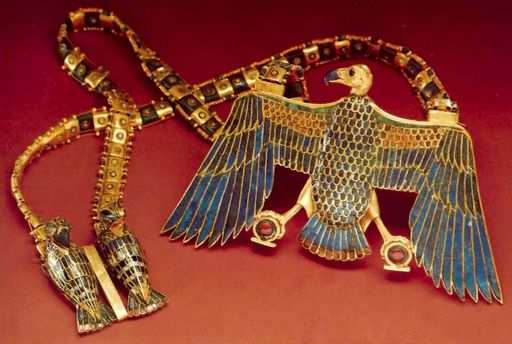
Seven sarcophagi placed one inside the other were opened by archaeologists before they got to the eighth, which contained the pharaoh’s mummy. The final decisive moment has arrived. Several golden studs were taken out, then the lid of the coffin was lifted by the golden brackets. Before the archaeologists lay Tutankhamun …
“The complex and conflicting feelings that take possession of a person at such moments cannot be expressed in words,” Carter recalled. He saw “… a noble, with regular features, full of calm, gentle youthful face with clearly defined lips.” It turned out that Tutankhamun was of small stature and frail build; at the time of his death he was about 18–19 years old.

The mummy was decorated with just an incredible amount of jewelry. The face was covered with a mask of hammered gold with portrait features of the pharaoh. Under each layer of bandages, more and more treasures were discovered. Pharaoh was literally strewn from head to toe with gold and precious stones!

But even greater treasures were found in the tomb of Tutankhamun. Here were countless items of material and spiritual culture of the ancient Egyptians, and each of them could serve as a sufficient reward for a winter of difficult archaeological excavations. Moreover, the Egyptian art of an entire era was presented here in such a variety and such perfect samples that Carter had only a cursory glance to understand that a careful study of all these treasures “will lead to a change, if not a complete revolution in all previous views and theories” .
Furniture and utensils, jewelry, weapons, chariots and ship models – everything is striking in its variety of forms and beauty.
The gold mask of the king with lapis lazuli inlay is amazing in its perfection. A beautiful herma is a generational statue of Tutankhamun, made of wood, covered with primer and painted. A low crown, leaving the shells of the ears open, is pulled over the forehead. The delicate face is illuminated by the radiance of large black eyes. Remarkable is the golden statuette of Tutankhamun standing on a black leopard. A strong muscular beast easily carries the fragile figure of the king. The combination of ebony and gold is amazingly beautiful.

The most original portrait of Tutankhamun is a small head made of wood, covered with a thin layer of plaster and painted. Like the sun god, the pharaoh is born from a lotus flower. Tutankhamun is depicted here as quite young. The capricious mouth is touched by a painful smile, large slanting eyes look attentively into the distance. This is one of the most poetic images created in Egyptian art.
The entrance to Tutankhamun’s tomb (center) lies in front of the tourist center in Egypt’s Valley of the Pharaohs. Archaeologist John Romer fears that the Nile may flood the valley.
In the tomb of Tutankhamun, several models of ships made of wood were found: long barges with a bow and stern, decorated with lotus flowers, were intended for crossing to the “fields of the blessed”. Four barges of the same shape, but equipped with a throne, were supposed to serve the pharaoh during the daily following the sun on its way through the sky. A barque decorated with the heads of wild goats is made of alabaster. In the center of it rises a light canopy resting on columns with double capitals in the form of lotus and papyrus flowers.
Three large beds were an equally important find, their existence was known earlier from the paintings on the walls of the tombs, but, however, they still could not be found. These were amazing structures, with an elevation not for the head, but for the legs. On one of them there were images of lion heads, on the second – cow heads, on the third one could see the head of a half-crocodile-half-hippopotamus. Jewels, weapons and clothes were heaped on the couch, and a throne lay on top. Its back was so marvelously decorated that Carter subsequently claimed: “It is the most beautiful of all that has yet been found in Egypt.”

The painting of one of the caskets depicts a pharaoh in a chariot hunting lions. These scenes are filled with a dynamism that is striking for Egyptian art: the run of the royal horses is swift and unstoppable …

And here is the king’s front chariot itself. It was too large to be completely carried into the tomb, and therefore it, like the other three chariots, was sawn apart. In the lower part of her body is decorated with the heads of the ugly god Bes carved from wood. The heads are gilded, a bright red tongue is visible in the mouth, dark red eyes are outlined with stripes of purple paste. On the head of the god is a tiara of pale blue and dark purple feathers.

Outside, the chariot is decorated with a relief ornament consisting of a floral pattern and spirals. On the inside The chariot contains an image of the pharaoh in the form of a sphinx advancing on captive Libyans, blacks and Asians. Very expressive is the face of an elderly Libyan with a peculiar hairstyle decorated with feathers, the curly head of a Negro and the stern profile of a Syrian. And just as typical are the ivory Asian and the ebony negro depicted on the staff of the pharaoh, symbolizing the northern and southern opponents of Egypt.
On the back of a cedar chair, covered with openwork carvings, there is an emblem of eternity in the form of a figure frozen on its knees with arms outstretched in both directions. And here are the symbols afterlife: gilded head of a sacred cow and a snake deity. Here are the gilded figurines of guardian goddesses… The god of the underworld Anubis in the form of a jackal, guarding the entrance to the treasury… The pharaoh’s ceremonial weapons – daggers, swords, spears, decorated with gold… an idea of the beliefs and art of the ancient Egyptians: chests and caskets filled with jewels, countless fans, necklaces, amulets, scarabs – images of the sacred beetle.
“The only notable event in Tutankhamun’s life was that he died and was buried,” said Howard Carter. But even if this insignificant ruler was buried with such luxury, then what treasures were in the tombs of the great pharaohs Thutmose III, Seti I, Ramses II? There is no doubt that each of their burial chambers contained more jewels than the entire tomb of Tutankhamen. But all these colossal riches were destined to fall into the hands of robbers over the centuries.
Victims of the Curse:
1. Canary Carter. Swallowed by a cobra on the day the tomb was opened.
2 – 3. Lord Carnarvon, sponsor of the expedition. He died a few days later in Cairo he was bitten by a mosquito. Before his death, the 57-year-old philanthropist was delirious and remembered the name of Tutankhamen: “I heard the call, it attracts me.” On the day of the lord’s death, his beloved fox terrier expired on his family estate.
4 – 7. Died from strange diseases after the opening of the tomb: archaeologist Mace (he moved the stone that blocked the entrance to the main chamber); the American millionaire George Jay-Gold, a friend of Lord Carnarvon; Egyptologists Arthur Weigall and Georges Benedite.

8-13. Died shortly after in England: Westbrun, Carter’s secretary (found dead in his bed), and his father (thrown out of window); radiologist Archibald Reid, who took pictures of the mummy; industrialist Joel Wood (examined the crypt); wife of Lord Carnarvon and his half-brother. 
14 – 16. Mohammed Ibrahim, director of the archaeological department of Egypt, was hit by a car in 1966. His successor, Gamal Mehrez, died of heart failure in 1972 after the pharaoh’s gold was sent to an exhibition in London. Pilot Rick Lowry, who was transporting Tutankhamun’s mask to England, died of a heart attack.
17 – 22. Six criminals in 1978 tried to steal Tutankhamen’s death mask from the Cairo Museum. Two died suddenly before the trial, three – in prison. Only Adolf Senger was released. A few years later he was found in a Cairo hotel – in a pool of blood, with his mouth torn. There was a piece of paper on the table: “The curse has overtaken me. It will catch up with others – everyone who dared to touch the sarcophagus of Pharaoh Tutankhamun.
Howard Carter worked to find Tutankhamun’s tomb with his companion Lord George Carnarvon. In 1923, Lord Carnarvon died suddenly in a hotel in Cairo. The official cause of death was not precisely established, since the level of development of medicine in Egypt at that time was still weak. It was either pneumonia or blood poisoning from a razor cut.
It was after this death that the press began to actively “trumpet” about the “curse of Tutankhamen”. Talk began about some mythical fungi and microorganisms that the priests left to kill the robbers. And then Hollywood picked up the idea.
Of course, this is nothing more than fiction. Lord Carnarvon was not a 20-year-old boy, at the time of his death he was already 57 years old. Inflammation of the lungs and blood poisoning were deadly diseases in those days, since antibiotics had not yet been invented.
Howard Carter himself died in 1939 at the age of 64. Logically, if the curse exists, then it should have touched him first.
Another version says that there is no mysticism in the deaths of some members of the expedition. They were allegedly killed by the Egyptian secret services to hide the falsification. This version is more realistic, we will talk about it in detail.
